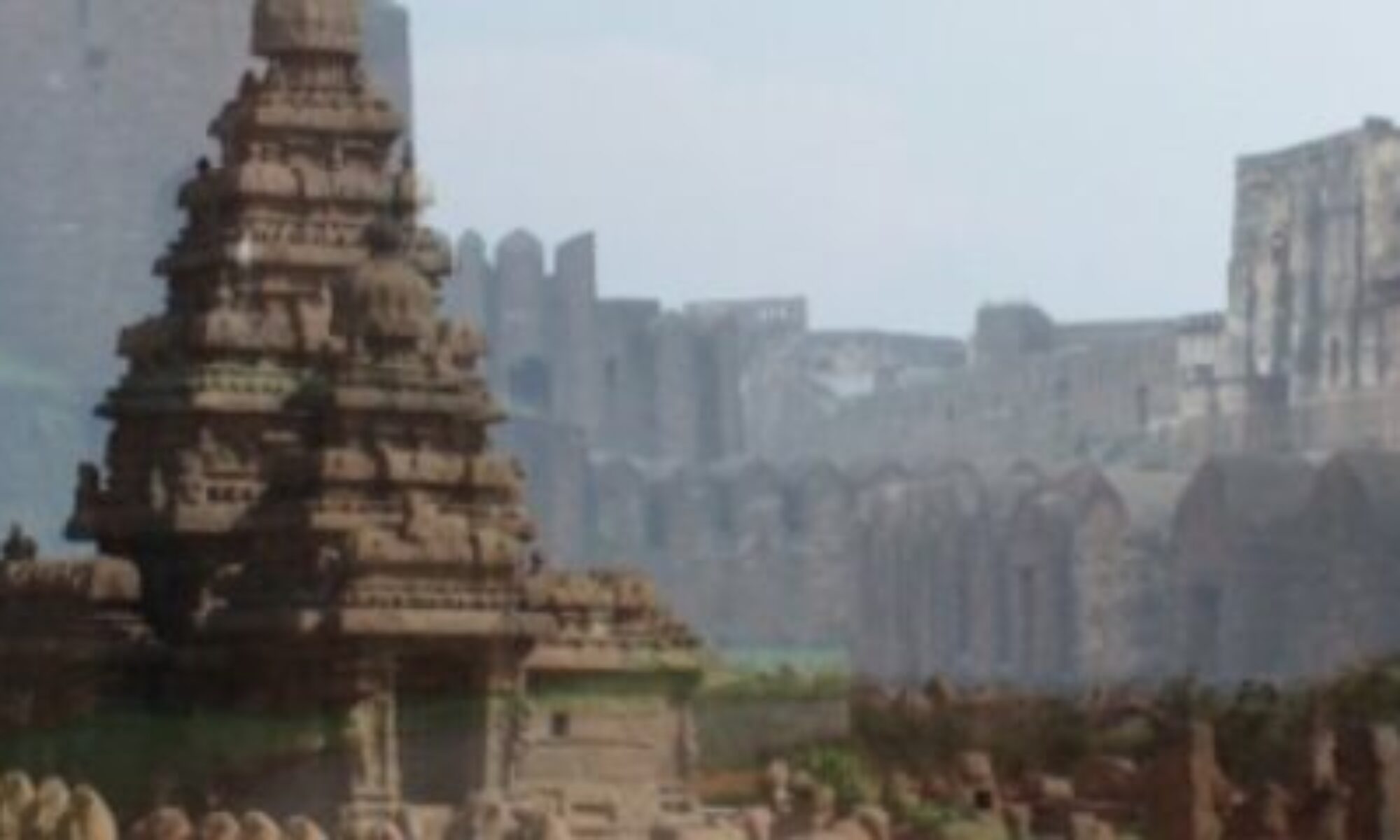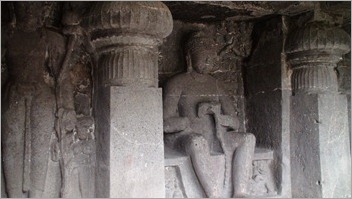 Proceeding from Cave 5, we enter a hall with a stair landing in it from the cave below. This hall, of which the left side is entirely gone, is 25 feet deep and 28 feet wide. On the right side, there are three cells, and on the back, has been separated from a still larger and a very lofty hall by two pillars and their corresponding pilasters, of which only one pillar and pilaster remain. The central hall was 25 feet wide and around 45 feet deep, exclusive of the ante-chamber at its right end, cut off by two pillars and their pilasters, as was another hall at the back 27 feet
Proceeding from Cave 5, we enter a hall with a stair landing in it from the cave below. This hall, of which the left side is entirely gone, is 25 feet deep and 28 feet wide. On the right side, there are three cells, and on the back, has been separated from a still larger and a very lofty hall by two pillars and their corresponding pilasters, of which only one pillar and pilaster remain. The central hall was 25 feet wide and around 45 feet deep, exclusive of the ante-chamber at its right end, cut off by two pillars and their pilasters, as was another hall at the back 27 feet 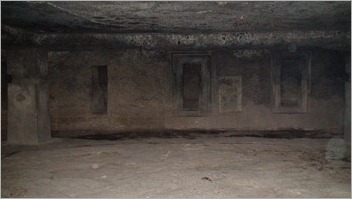 by 29, similar to that in front, with three cells and as many as in the right all with very high steps.
by 29, similar to that in front, with three cells and as many as in the right all with very high steps.
The ante-chamber in front of the shrine is filled with sculpture. On on the back is a female dressed exactly in the garb of Padmapani, who is the gigantic dwarapala on the north side of the shrine door. On the left end is a similar female figure with a peacock at her left hand.; below is a pundit reading. This is 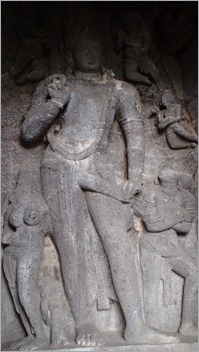 supposed to represent Saraswati, the goddess of learning. Some representations attribute this figure to Pandara or Padmani, the sakti of Amitabha and the mother of Padmapani. Over the panel is a makara torana, which is very unique for a Buddhist cave. The dwarapalas are tall and carefully cut, with foilate over their heads and attendants beside them. A female stands between each and the door. The door is lofty and boldly cut.
supposed to represent Saraswati, the goddess of learning. Some representations attribute this figure to Pandara or Padmani, the sakti of Amitabha and the mother of Padmapani. Over the panel is a makara torana, which is very unique for a Buddhist cave. The dwarapalas are tall and carefully cut, with foilate over their heads and attendants beside them. A female stands between each and the door. The door is lofty and boldly cut.
I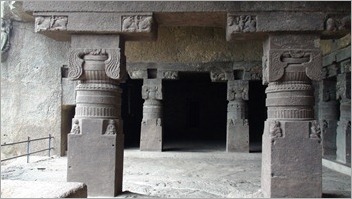 n the shrine, is a large image of Buddha seated, with the usual attendants. On the side walls are three rows, containing each three Buddhas with their feet turned up while below them on each side are worshippers and others. On the right side of the shrine is a panel containing three figures on lotus seats. The left one may easily be identified as Avalokiteswara with the lotus and rosary; and the deerskin over his shoulder; also a figure of Amitabha Buddha on
n the shrine, is a large image of Buddha seated, with the usual attendants. On the side walls are three rows, containing each three Buddhas with their feet turned up while below them on each side are worshippers and others. On the right side of the shrine is a panel containing three figures on lotus seats. The left one may easily be identified as Avalokiteswara with the lotus and rosary; and the deerskin over his shoulder; also a figure of Amitabha Buddha on 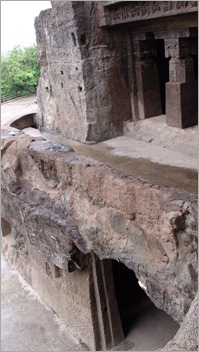 the front of his head-dress. Whom the other two figures represent is not clear.; he central one is very fat and holds what resembles a small book in his left hand, and some round object in his right, while his head-dress is unlike any other. He has rich armlets, heavy earrings, a necklace and janvi. The third figure holds a small flower in his right hand, wears a high head-dress, a necklace, long ear pendants, armlets, bracelet, and a thick cord worn as a janvi. Probably this is Manjushri. All three have aureoles behind their heads.
the front of his head-dress. Whom the other two figures represent is not clear.; he central one is very fat and holds what resembles a small book in his left hand, and some round object in his right, while his head-dress is unlike any other. He has rich armlets, heavy earrings, a necklace and janvi. The third figure holds a small flower in his right hand, wears a high head-dress, a necklace, long ear pendants, armlets, bracelet, and a thick cord worn as a janvi. Probably this is Manjushri. All three have aureoles behind their heads.
On the left side wall of the same room is a similar compartme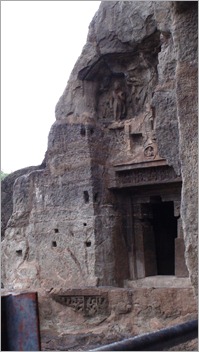 nt, which contains first, to the right, a male figure with headdress, earrings, necklace, and janvi on bended knees, and attended by a female presenting an offering. Behind him is a female figure, probably his wife, also with rich turban and enormous earrings, on her knees and with her hands in the attitude of adoration. She is attended by a female dwarf, who bears a box or tray with presents, and over her head is a bird apparently placed as a sort of cognizance. Behind the female again, bends on one knee is a male figure with necklace and janvi, holding something like a large bag or purse. Close to him is an elephant’s head and fore-foot, with a small figure representing the driver leaning over his brow. This must be intended to represent some wealthy family making an offering to the cave or its priest; it may be a price with is wife and manager.
nt, which contains first, to the right, a male figure with headdress, earrings, necklace, and janvi on bended knees, and attended by a female presenting an offering. Behind him is a female figure, probably his wife, also with rich turban and enormous earrings, on her knees and with her hands in the attitude of adoration. She is attended by a female dwarf, who bears a box or tray with presents, and over her head is a bird apparently placed as a sort of cognizance. Behind the female again, bends on one knee is a male figure with necklace and janvi, holding something like a large bag or purse. Close to him is an elephant’s head and fore-foot, with a small figure representing the driver leaning over his brow. This must be intended to represent some wealthy family making an offering to the cave or its priest; it may be a price with is wife and manager.
On the north side of the front hall a passage divided from a balcony or small cave by two pillars is the only way of access to a shrine which I would be disposed to call it the Cave 9.
We shall now proceed further to Cave 7.
